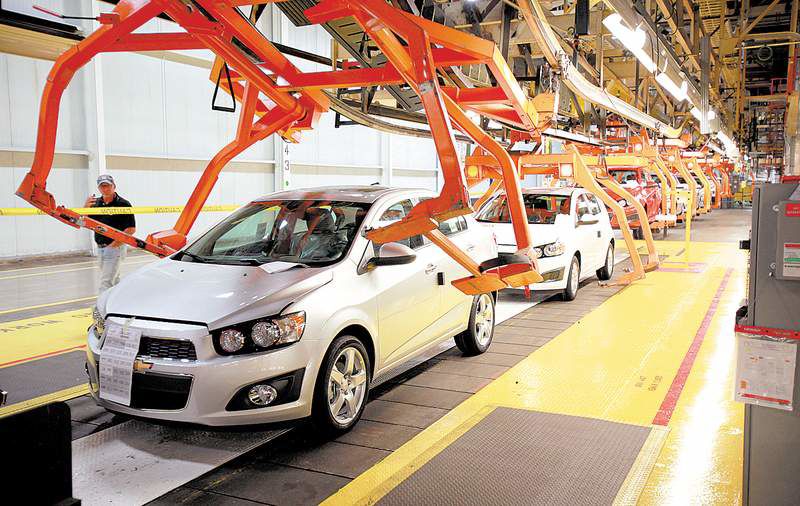Union enables GM to reinvent the U.S.-made subcompact car
Published 5:00 am Friday, July 15, 2011

- Challenging the auto industry's assumption that no company can build a subcompact car in the U.S. and make money, GM is building the Chevrolet Sonic with new low-cost methods and union cooperation at a plant in Lake Orion, Mich.
ORION TOWNSHIP, Mich. — The only subcompact car being built on U.S. soil will soon roll out of an assembly plant here in suburban Detroit that is as unusual as the car itself.
The production line has been squeezed into half the space of a traditional plant. Welding robots are concentrated in efficient clusters, instead of being spaced along the line, while many of the workers earn half the typical union wage. Even the first coat of rust-proofing has been reformulated so that it is one-hundredth as thick as — and thereby cheaper than — the coating on other cars.
One of the oldest axioms in the auto industry is that no company can build a subcompact car in the United States and make money because they are priced too low. The Ford Fiesta is built in Mexico. The Honda Fit is made in several places, including China and Brazil. But with Americans — and Detroit — rediscovering small cars because of high gasoline prices, General Motors is intent on shattering that notion with its new Chevrolet Sonic. The car, with a base price of around $14,000, will give GM a new entry in the lowest tier of the market when it goes on sale this fall. The Sonic is also expected to be a breakthrough in establishing a new level of cooperation between Detroit and the United Automobile Workers.
The radically revamped factory here operates with fewer and cheaper workers, many of whom are paid $14 an hour rather than the full UAW wage of $28 an hour.
The plant itself is smaller and reconfigured to save money, with company executives modeling some of the changes after GM’s most efficient factories in Germany and Korea. The production line’s footprint alone was reduced from 1 million square feet to 500,000 — the equivalent of losing the space of more than two Walmart supercenters. The energy bill was cut by powering some operations with methane gas from neighboring landfills.
Making it possible
The Sonic will be GM’s littlest, and most fuel-efficient, conventionally powered vehicle. It was conceived in 2008, before the federal government’s bailout of the bankrupt automaker, when negotiators from the company and the union began brainstorming about what it would take to make a profitable subcompact car in the United States rather than in low-wage countries.
“We wanted to prove we could do it,” said Diana Tremblay, GM’s head of labor relations, “and we went into it with an open mind.”
The UAW tried to persuade the Ford Motor Co. to build the Fiesta subcompact in the United States. But Ford chose a plant in Mexico, where the combined wages and benefits of a production worker total less than $10 an hour. By contrast, a full-wage union member in the United States costs GM close to $60 an hour. Even an entry-level-wage employee costs about $30 an hour in wages and benefits.
While it is not the only factor in producing a profitable subcompact, lower employment costs were critical to the decision to build the Sonic in Michigan. In a groundbreaking labor agreement, the union allowed GM to pay 40 percent of its union workers at Orion Township an “entry-level” wage that sharply reduces overall production costs.
“The entry-level-wage structure was an important enabler, because obviously the smaller the car the less the margin,” said Tremblay.
The UAW’s president, Bob King, said the union considered the significance of a competitive subcompact to GM’s overall product lineup. The Sonic is the first subcompact that GM has tried to build in its home market since the Chevrolet Chevette almost 40 years ago, aside from a brief joint effort with Toyota to build Geo Prizms. The smallest car in its lineup now is the Chevrolet Aveo, a subcompact developed by GM’s South Korean subsidiary. A version of the Sonic to be sold overseas will be built in South Korea.
Convincing consumers
For all its promise, the Sonic still has to convince consumers that GM has found the right formula for an attractive and affordable subcompact. Previous efforts like the Geo Prizm and the Aveo were bland and underpowered, and contributed to GM’s lackluster reputation in the overall car market.
The Sonic weighs 500 pounds less and is 8 inches shorter than the next biggest car GM makes, and its little 1.4-liter turbocharged engine will deliver the best gas mileage in the company’s fleet. “It will be north of 40 miles per gallon,” said Jim Federico, head of GM’s global small cars and electric vehicles.
Still, to get the car to meet cost-saving goals, a team of GM engineers and manufacturing specialists also had to adapt and reconfigure the Orion plant. It opened in 1983, and was used to build big cars like the Buick Riviera in the 1990s.
GM spent heavily in converting the plant, investing $545 million in new equipment and retraining workers — and it shows, from the gleaming floors to the banks of fluorescent lighting that brighten the plant and save $430,000 a year in energy costs. The plant is also the company’s greenest, producing 80 percent less solid waste and using 20 percent less water, all at a savings.
Every dollar saved is essential for the Sonic to compete, auto experts said. And if the car is a winner with consumers — production begins in August — Orion Township could become a model.
“This plant has the potential to redefine American manufacturing,” said Harley Shaiken, a labor professor at the University of California, Berkeley. “A success here indicates untapped capabilities.”






